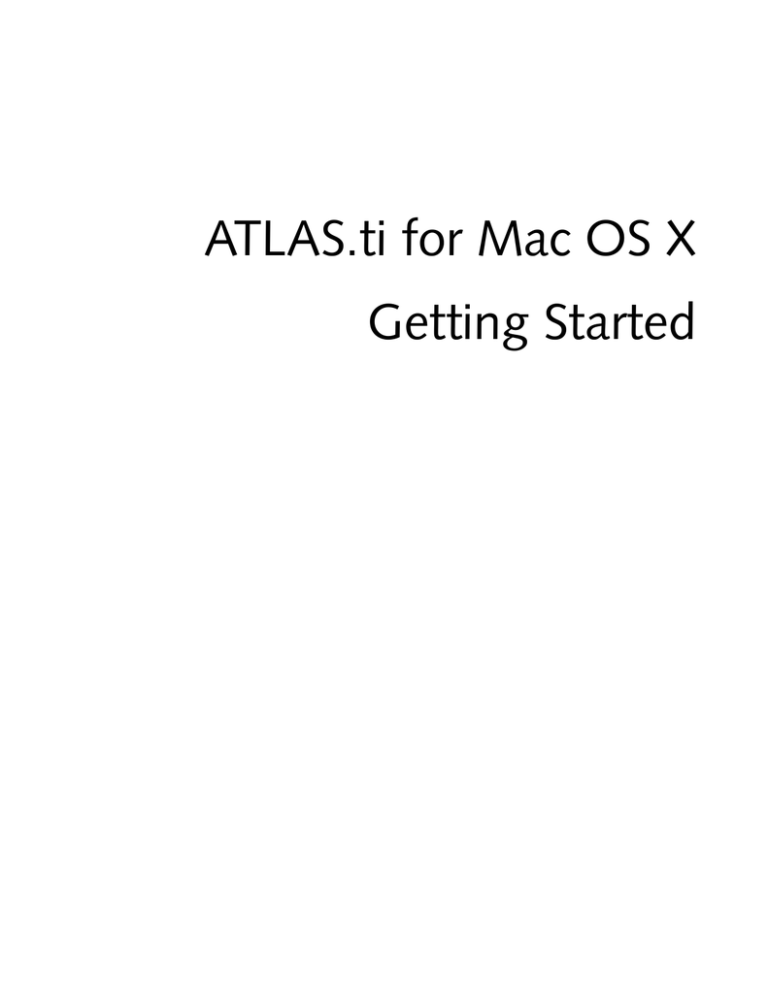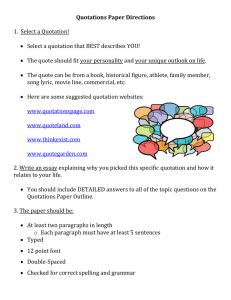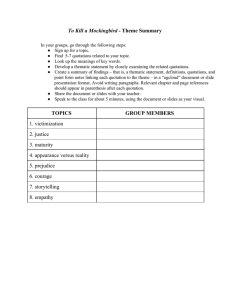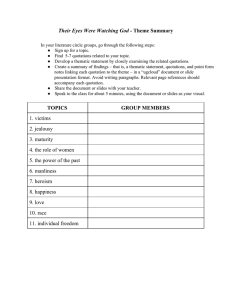
ATLAS.ti for Mac OS X
Getting Started
2
ATLAS.ti for Mac OS X– Getting Started
Copyright ©2014 by ATLAS.ti Scientific Software Development GmbH, Berlin. All rights reserved.
Manual Version: 5.20140918. Updated for program version: 7.5
Author: Dr. Susanne Friese (QuaRC)
Programming/Design/Layout: www.hypertexxt.com
Copying or duplicating this manual or any part thereof is a violation of applicable law. No part of this manual may be reproduced or
transmitted in any form or by any means, electronic or mechanical, including, but not limited to, photocopying, without written
permission from ATLAS.ti GmbH.
Trademarks: ATLAS.ti is a registered trademark of ATLAS.ti Scientific Software Development GmbH. Adobe Acrobat is a trademark of
Adobe Systems Incorporated; Microsoft, Windows, Excel, and other Microsoft products referenced herein are either trademarks of
Microsoft Corporation in the United States and/or in other countries. Google Earth is a trademark of Google, Inc. All other product
names and any registered and unregistered trademarks mentioned in this document are used for identification purposes only and remain
the exclusive property of their respective owners.
ATLAS.ti for Mac – Getting Started
3
Contents
Introduction..............................................................................................................................4
The Interface ...................................................................................................................................................................4
Creating A New Project....................................................................................................................................................7
Importing Projects From Other ATLAS.ti Applications.......................................................................................................7
Project Management........................................................................................................................................................7
Adding And Loading Documents......................................................................................................................................9
Working With Codes......................................................................................................................................................10
Working With Quotations..............................................................................................................................................13
Working With Memos....................................................................................................................................................16
Visualizing Your Thoughts And Ideas In Network Views.................................................................................................18
Analysis Options.............................................................................................................................................................21
Creating Reports.............................................................................................................................................................24
ATLAS.ti for Mac – Getting Started
INTRODUCTION
4
Introduction
This Getting Started Guide provides an overview of the main features of
ATLAS.ti for Mac 1.0, the younger sibling of ATLAS.ti for Windows. It is
written for users with no prior experience of working with ATLAS.ti, but also
for users new to the Mac version.
This very first version for Mac does not yet contain all features of the Windows
version, therefore we recommend it for the following user group:
• Single users who want to start working on a new project
• Single users who already started a project under Windows but are still in the
coding phase
• Single users who want to work within the Mac environment they love and
are familiar with but do not have sophisticated analysis needs (see “Analysis
Options“ on page 21).
This version does not yet support team projects !
There are quite a number of neat new features in ATLAS.ti for Mac that are not
available under Windows, such as the inspectors, the quotation display in the
Quotation Manager, the way of handling audio and video data, the Undo
function, full unicode support, and more. For a full comparison of features see:
http://www.atlasti.com/uploads/media/mac-a7_feature_matrix_201409.pdf
The table (and this guide) will be updated on a regular basis to reflect the
functionality and features that will be added to the Mac version in the coming
months.
In developing ATLAS.ti for Mac, the aim was to create a software for Mac users
that makes them feel at home, not just a copy the Windows version. Therefore,
the two versions will never be completely identical. Yet, some of the features
that you already find in the Mac version will also be implemented in ATLAS.ti
8. The Windows version and the Mac version will “learn” from each other and
will continue to inspire future development.
The Interface
Below you see the main features of the ATLAS.ti for Mac interface:
ATLAS.ti for Mac – Getting Started
INTRODUCTION
5
Figure 1: The ATLAS.ti for Mac user interface
The main entities are symbolized by the following icons:
Figure 2: Entity representation
Personalize Your Screen
A number of panes that you see in the default interface view can be hidden like
for instance the navigator or the inspector. If this is possible, you see a little
icon or a text “Hide” / “Show” that you can click.
ATLAS.ti for Mac – Getting Started
INTRODUCTION
6
Figure 3: Hide or show optional panes
Finding Your Way Around The Software
If you are not sure where to find a function, just search for it under HELP. For
instance you want to know where the Relation Manager is. Typing in the first
letters of a search term, shows a list of hits.
When selecting an entry that seems to be the one that you are looking for, it
will show you where you can find it. Click on the selected hit in the list, and
ATLAS.ti for Mac will open up the function for you.
Figure 4: Finding quickly what you are looking for
Creating A New Project
When you open ATLAS.ti for Mac for the first time, you have two choices: to
create a new project or to import an existing one from other ATLAS.ti
applications.
Select CREATE
A NEW
ATLAS.TI PROJECT and enter a project name:
ATLAS.ti for Mac – Getting Started
INTRODUCTION
7
Figure 5: Creating a new project
Importing Projects From Other ATLAS.ti Applications
If you previously used ATLAS.ti for Windows version, you need to update to
version 7.5. From there you can export your projects using the following
option: PROJECT / EXPORT / MAC TRANSFER BUNDLE.
You can also export your Ipad and Android projects to be used in ATLAS.ti for
Mac. Please update the apps if you have not recently done so.
On your Mac, double-click on the exported file or use the import option
shown above.
Project Management
Project Management is simple. Similar to iTunes, ATLAS.ti is saving your project
data at a location that is provided for each application. This location is user
specific. If more than one user is using the same computer, you need to log in
under your personal user name to access your ATLAS.ti projects.
You can close, rename, duplicate, delete and export projects. You find these
options under the Project menu and in the Open Project window (PROJECT /
OPEN), when you right-click on a project name (see below):
ATLAS.ti for Mac – Getting Started
INTRODUCTION
8
Figure 6: Project management options
Project Backup And Transfer
To create a backup copy of your project, or to transfer a project to a different
computer, select PROJECT / EXPORT PROJECT...
ATLAS.ti for Mac – Getting Started
INTRODUCTION
9
Adding And Loading Documents
ATLAS.ti for Mac supports text (Word (doc and docx), RTF, OpenOffice (.odt),
PDF, image, audio and video files (all file formats supported by QuickTime).
Documents are imported and your project is saved silently.
To add documents, select PROJECT / ADD DOCUMENTS / IMPORT DOCUMENTS....
Figure 7: Adding documents to a project
All loaded documents can be accessed via the navigator that you find on the
left-hand side of the screen, or via tabs. If you later on have memos and
network views, they can also be accessed this way.
Load one or more documents with a double-click on the document in the
navigator.
Figure 8: Loading documents
ATLAS.ti for Mac – Getting Started
INTRODUCTION
10
Working With Codes
After adding documents, you can begin to code your data.
If you do not want to code your data right away, instead read, highlight
and comment on selected data segments, take a look at the section
“Working With Quotations“ on page 13.
To code a data segment, highlight it with your mouse and select the ADD
CODING button:
Figure 9: Coding a selected data segment
After coding, the quotation name and the code label are displayed in the
margin area:
Figure 10: Display of coded
segment in the margin area
ATLAS.ti for Mac – Getting Started
INTRODUCTION
11
Coding image, audio or video data works in the same way: You highlight a
segment with your mouse, click on the Add coding button (or right-click and
select Add Codes), and enter a code. When coding audio or video data, you
highlight a segment on the audio-wave form (see Figure 15 below).
The Code Manager
Open the Code Manager by clicking on the button CODES above the
document area, or select CODE / SHOW CODE MANAGER from the main menu.
In the Code Manager you can add code colors, write a comment for each
code, retrieve coded segments, create code groups or use it for drag & drop
coding.
Figure 11: The Code Manager
Click on the circle in the “color column” just before the code name and
select a color for each code. In Figure 12 below you see how code colors are
displayed in the margin.
If you want the Code Manager to stay on top, click on the pin icon in the
top right-hand corner.
ATLAS.ti for Mac – Getting Started
INTRODUCTION
12
Figure 12: Setting code colors
Coding With Existing Codes
You can either drag & drop a code from the Code Manager onto a selected
data segment, or as shown in the Figure 13 below, from the navigator:
Figure 13: Coding via drag & drop
ATLAS.ti for Mac – Getting Started
INTRODUCTION
13
Creating (Code) Groups
Codes, documents and memos can be grouped. Groups are the equivalent to
“families” in ATLAS.ti for Windows. Groups can be used for sorting and
organizing purposes, but also as filter. Currently groups can be used to set local
filters, which means a filter only applies to the currently open window and not
to the entire project. Global filter options will be added in the future.
This is how you create groups:
Open one of the Managers. Click on the plus sign at the bottom of the
Groups pane or right-click inside the Groups pane and select NEW GROUP.
Enter a group name.
Add members to the group via drag and drop from the list of documents /
codes / memos in the manager.
If you click on a group, the items in the manager are filtered and only the
members of the selected group are listed.
Click on SHOW ALL
CODES
to reset the filter.
To remove an item from a group, open the Groups Manager, e.g. via the main
menu (Show Documents / Codes / Memos Group Manager), or by rightclicking on a group in a manager. Select: OPEN IN GROUP BROWSER.
Figure 14: Working with code groups
Working With Quotations
It is not always desired to start setting codes immediately. You can begin by
identifying interesting segments in your data, mark them and comment on
them. This is exemplified below based on a video document.
In a video or audio document, you create a quotation simply by highlighting
an area on the audio-wave form. For all other document types, you need to
ATLAS.ti for Mac – Getting Started
INTRODUCTION
14
click on the button QUOTATION FROM SELECTION. Soon you will also be able to
select this option from the context menu.
After creating a quotation, you can modify the default name and write a
comment in the inspector (see Figure 15).
Figure 15: Create quotations, add names and write comments
To keep track of your data and your thoughts open the Quotation Manager by
clicking on the Quotations button, or select QUOTATION / SHOW QUOTATION
MANAGER from the main menu:
Figure 16: Quotation Manager
ATLAS.ti for Mac – Getting Started
INTRODUCTION
15
Each quotation automatically receives an ID and a name. The default name is
quotation 1, quotation 2, quotation 3 and so on and can be renamed. If a
quotation contains text, the first 100 characters are included in the column
'text content'.
The quotation ID consists of the document number and a number indicating
the chronological sequence when a quotation was created in the document.
Thus, quotation 9:5 comes from document 9 and was the fifths quotation that
was created in this document.
When you select a quotation in the list, its content is displayed in the bottom
pane. This is a convenient way to browse through your quotations.
When selecting a code on the left-hand side, a filter is set and only the
quotation(s) coded with the selected code are shown in the list.
In the Inspector on the right-hand side you can modify the quotation name and
review or edit quotation comments.
Creating Hyperlinks
To link two quotations to each other, simply drag one quotation and drop it
on top of another quotation – either in the Quotation Manager or in the
margin area.
Next, select one of the offered relations. If the offered relations do not suit
your needs, you can create new relations in the Relations Manager:
QUOTATIONS / SHOW RELATIONS MANAGER.
Figure 17: Linking two quotations to each other in the Quotation Manager
ATLAS.ti for Mac – Getting Started
INTRODUCTION
16
Working With Memos
Open the Memo Manager by clicking on the Memos button or select MEMO /
SHOW MEMO MANAGER from the main menu.
Click on the + sign to add a new memo. Enter a name.
Double-click to open it. It will open as new tab.
You can also open a memo into its own region, so that you can see both the
memo and your data. To do so, drag the memo tab to the right, left, top or
bottom edge of the document area. If you see a blue stripe, you can drop it
(see figure below).
Figure 18: Open a memo, document or network in a new region
You are free to split your screen vertically or horizontally:
ATLAS.ti for Mac – Getting Started
INTRODUCTION
17
Figure 19: Alternative arrangements of documents and memo
To link a memo to a data segment, drag & drop it from the Memo Manager
onto a quotation, or select a memo in navigator and drag & drop it from
there.
When selecting a memo in the margin area, the inspector on the right-hand
side is displaying the detailed information for this memo (see Figure 20).
Figure 20: Working with memos
ATLAS.ti for Mac – Getting Started
INTRODUCTION
18
Visualizing Your Thoughts And Ideas In Network Views
To create a new network view, select NETWORK / NEW NETWORK. Enter a name.
Drag and drop items from the Managers, margin area, or the navigator into
the view.
The node types (document, quotation, code, memo, network view) can be
recognized by their entity specific icon (compare Figure 2). If you right-click on
a node, you see further options that are available ( Figure 21).
Figure 21: Node types and available options
Linking Nodes
To link for instance two codes to each other, select a code node. A circle
appears at the top left corner of the node. Drag the circle to another cpde
node and left-click. A list of relation opens. Select the one that best fits the
relation between the two codes.
You can also create your own relations in the Relation Manager (see CODES /
SHOW RELATION MANAGER).
ATLAS.ti for Mac – Getting Started
INTRODUCTION
19
Figure 22: Linking two code nodes
Named relations can be created between two codes and between two
quotations. The latter are called hyperlinks in ATLAS.ti (see also “Creating
Hyperlinks“). Other objects can be linked, but you cannot specify the relation
between them. This applies to
Code – Memo / Code – Quotation (this is the same as coding) / Memo –
Memo and Memo – Quotation links.
You can also display groups and their contained entities (see “Importing
Neighbors“ below), or add a new item to the group by linking it via drag and
drop. The difference is that you cannot name this link.
It is possible to display the quotations that are contained within a document,
via the importing neighbor option, but you cannot link a quotation to a
document in a network view. It would not make much sense. e.g. to link a
quotation from document 5 to document 3, as it does not belong to it. What
you can do is to link it to a quotation of document 3, which means creating a
hyperlink.
Importing Neighbors
Neighbors are all entities that are directly linked to a node. For codes these
could be other codes, memos, quotations or code groups. Depending on the
node type you click, you are offered the choices that apply.
To import neighbors in a network view, right-click on a node and make your
choice:
ATLAS.ti for Mac – Getting Started
INTRODUCTION
20
Figure 23: Importing code neighbors
The figure below offers a preview of how your network views might look like
one day. On the right-hand side you see the inspector, providing further
information on the network view.
Figure 24: Example of a more elaborated network view
ATLAS.ti for Mac – Getting Started
INTRODUCTION
21
Analysis Options
The analysis options in version 1.0 of ATLAS.ti for Mac are still limited. You can
retrieve quotations by code(s), either by double-clicking on a code in the Code
Manager or Navigator, or by selecting one or more codes in the Quotation
Manager. This allows you to run simple AND and OR queries.
Another available option is to look for code cooccurences in the CodeCoccurence Table.
Simple AND / OR Queries In The Quotation Manager
Open the Quotation Manager. At the bottom of the screen you see a VENN
diagram. You can set it to AND or OR.
Figure 25 below shows the result of an example AND query. The two codes
'#fam: have children' and '#fam:t-teenagers' have been selected holding down
the cmd key. The quotation list displays the resulting 6 quotations that contain
all comments written by parents of teenage kids.
The quotation content is displayed in the bottom pane.
Figure 25: Running an AND query in the Quotation Manager
Code Cooccurence Analysis
You find the Code Cooccurence Table under the ANALYSIS menu. The example
query shown in Figure 26 below compares the answers provided by
ATLAS.ti for Mac – Getting Started
INTRODUCTION
22
respondents with and without children (column codes) with regard to a
number of different issues (row codes):
Figure 26: Code Cooccurence Table
To create such a table select column and row codes on the left-hand side by
ticking the boxes in front of the codes. The table fills in automatically when
selecting row codes.
Click on a cell in the table to view the resulting quotations in the pane at the
bottom. Double-click to access a quotation in context.
Currently the output option consists of exporting the table as Excel-compatible
file in csv format. Other options including a full report of all cooccuring
quotations will follow.
The C-Coefficient
The calculation of the c-coefficient is based on approaches borrowed from
quantitative content analysis. Thus, interpreting such a coefficient is only
meaningful with a sizable data set and not for an interview study with 10
respondents.
The c-coefficient should vary between 0: codes do not co-occur, and 1: these
two codes co-occur wherever they are used. It is calculated as follows:
c := n12/(n1 + n2) – n12
n12 = co-occurrence frequency of two codes c1 and c2, whereby n1 and n2
are their occurrence frequency
ATLAS.ti for Mac – Getting Started
INTRODUCTION
23
What you may experience is the following:
• Out of range. The C-index exceeds the 0 - 1 range it is supposed to stay
with.
• Colored circles. Cells can have additional visual cues, e. g., a red, yellow or
orange circle.
OUT OF RANGE
The c-index (structurally resembling the Tanimoto and Jaquard Coefficient,
which are similarity measures) assumes separate non-overlapping text entities.
Only then can we expect a correct range of values. However, ATLAS.ti’s
quotations may overlap to any degree.
Figure 27: Out of range example 1
Case 1: Two differently coded quotations overlap, we assume no more
quotations available. Let P1 be a textual document, q1 and q2 be quotations
and a,b be codes. q1 is coded with a, q2 is coded with b.
Using the formula: c := n_ab/(n_a + n_b) – n_ab, we get:
n_ab = 1 one co-occurrence of a and b
n_a = 1, n_b = 1 a and b each code exactly one quotation.
c = 1/(1 + 1) – 1 = 1
Such a scenario results in the maximum co-occurrence of 1 !
Case 2: q1 is coded with both codes a and b, the overlapping quotation q2 is
coded with b.
Figure 28: Out of range example 2
n_ab = 2. q1 alone counts for a co-occurrence event and the overlapping
q1*q2 for another.
n_a = 1, n_b = 2
c = 2/(1 + 2) – 2 = 2!!
This results in a value of twice the allowed maximum. Thus, the C index is not
appropriate to correctly represent co-occurrence in redundantly overlapping
ATLAS.ti for Mac – Getting Started
INTRODUCTION
24
texts. If the c-coefficient exceeds 1, you need to do some cleaning up and
eliminate the redundant codes.
COLOR INDICATORS
Red circle: When the c-index exceeds 1 (see “Out of range“ on page 23).
Yellow circle: An inherent issue with the C-index and similar measures is that it
is distorted by code frequencies that differ too much. In such cases the
coefficient tends to be much smaller than the potential significance of the
cooccurrence. For instance, if you had coded 100 quotations with code
"depression" and 10 with "mother" and you had 5 co-occurrences:
n_dep = 100, n_mother = 10, n_dep-mother = 5
c = 5/(100 + 10) - 5 = 5/105 = 0.048
A c index of only 0.048 may slip your eye easily, although code "mother"
appears in 50% of all its applications with code "depression". Looking from
code "depression" only 5% cooccurr with code "mother".
If the ratio between the codes frequencies exceeds a certain threshold
(currently 5) the yellow light goes on in the cell. So whenever a cell shows the
yellow marker it should invite you to look into the co-occurrences of this cell
despite a low c-index.
Orange Circle: The orange circle is simply a mixture of the red and yellow
conditions.
Creating Reports
You find an output option under the main menu of each entity type:
Document, Quotation, Code, Memo and Network. Currently all output options
refer to the entire project. You cannot for instance export quotations of just
one code. Such reports will however be implemented soon.
Below a few output options are shown as examples:
DOCUMENTS / OUTPUT / LIST
OF
DOCUMENT GROUPS
AND THEIR
MEMBERS
ATLAS.ti for Mac – Getting Started
INTRODUCTION
25
Figure 29: Documents / Output / List of Document Groups and their Members
QUOTATIONS / OUTPUT / QUOTATIONS BY CODE
Figure 30: Quotations / Output / Quotations by Code
ATLAS.ti for Mac – Getting Started
INTRODUCTION
26
CODES / OUTPUT / CODE BOOK
Figure 31: Codes / Output / Code Book
The currently available reports are based on the style sheets provided in the
XML Explorer in ATLAS.ti for Windows.
ATLAS.ti for Mac – Getting Started



